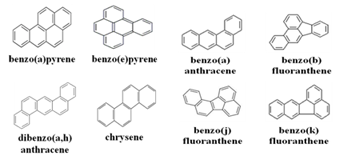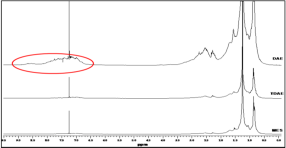
Oil is generally added in rubber compounds to improve processing properties, low temperature properties, dispersion of fillers, and to reduce cost. Widely used oils in tire compounds are highly aromatic oils because they provide good compatibility with both natural and synthetic rubbers. Highly aromatic oils contain a high concentration of polycyclic aromatic hydrocarbons (PNAs).
PNAs are organic compounds possessing two or more aromatic rings, of which eight types are identified as carcinogens (Fig. 1). PNAs are released into the environment by tire wear and are bound to particles which later end up as sediments. Other PNAs are bioconcentrated in invertebrates in the aquatic environment and are enriched in the food chain. Due to a driving force from health and environmental risk awareness and an EU regulation1, non-carcinogenic oils are in need to replace high PNA containing oils.

Fig.2 1H NMR spectra of DAE, TDAE and MES oils.
The 1H-NMR spectra that clearly show that the DAE oils (PNA containing oil) contain a substantial amount of aromatic protons related to the PNAs in the chemical shift range of 6.6 to 9.0 ppm.
The aromatic protons in treated distillate aromatic extract (TDAE) and mildly extracted solvate (MES) oils mostly disappear indicating a greatly reduced PNAs content in these oils when compared with DAE.
Ref.: 1Commission Regulation (EC) No 552/2009. Official Journal of the European Union, L164/7-31.
Aim of the project:
This research investigates the influences of PNA-low extender oils, i.e. TDAE and MES, on the performance properties of NR-based truck tire tread compounds and NR/SBR-based passenger tire tread compounds.
For more information regarding this project, contact A. Petchkaew

![]()
![]()

